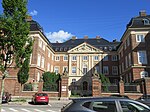Swedish Gustaf's Church
20th-century Church of Sweden church buildingsArt Nouveau architecture in CopenhagenArt Nouveau church buildings in DenmarkChurches completed in 1911Lutheran churches in Copenhagen

Swedish Gustaf's Church (Swedish: Svenska Gustafskyrkan), part of the Church of Sweden Abroad, is the church of the Swedish congregation in Copenhagen, Denmark. It was built between 1907 to 1911 to the design of Swedish architect Theodor Wåhlin (1864-1948) and is named after King Gustaf V of Sweden.
Excerpt from the Wikipedia article Swedish Gustaf's Church (License: CC BY-SA 3.0, Authors, Images).Swedish Gustaf's Church
Folke Bernadottes Allé, Copenhagen Østerbro
Geographical coordinates (GPS) Address Website External links Nearby Places Show on map
Geographical coordinates (GPS)
| Latitude | Longitude |
|---|---|
| N 55.692222222222 ° | E 12.59 ° |
Address
Svenska Kyrkan (Den svenske kirke)
Folke Bernadottes Allé
1328 Copenhagen, Østerbro
Capital Region of Denmark, Denmark
Open on Google Maps











